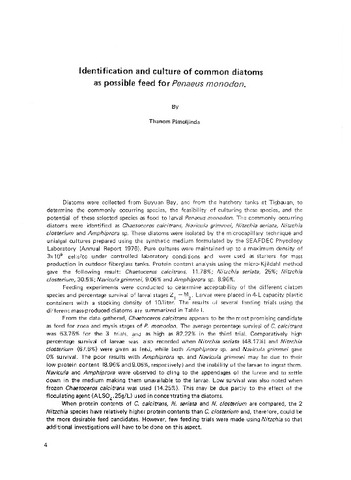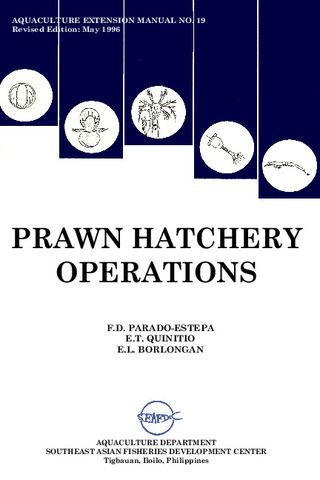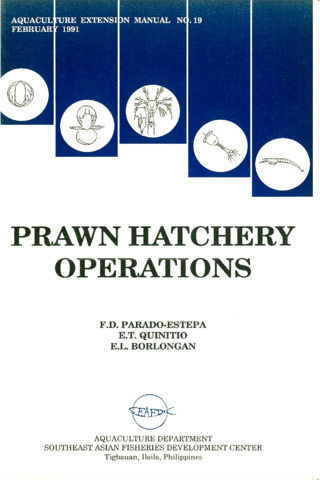Identification and culture of common diatoms as possible feed for Penaeus monodon
- Global styles
- MLA
- Vancouver
- Elsevier - Harvard
- APA
- Help
Share
抄録
Diatoms were collected from Buyuan Bay, and from the hatchery tanks at Tigbauan, to determine the commonly occurring species, the feasibility of culturing these species, and the potential of these selected species as food for larval P. monodon. The commonly occurring diatoms were identified as Chaetoceros calcitrans, Navicula grimmei, Nitzchia seriata, Nitzchia closterium and Amphiprora sp. These diatoms were isolated and unialgal cultures prepared. Protein content analysis using the micro-Kjildahl method gave the following result: C. calcitrans, 11 . 78%; Nitzchia seriata, 25%; Nitzchia closterium, 30 . 5%; Navicula grimmei, 9 . 06% and Amphiprora sp. 8 . 96%.
Feeding experiments were conducted to determine acceptability of the different diatom species and percentage survival of larval stages Z1 - M2. Larvae were placed in 4-l capacity plastic containers with a stocking density of 10/l. The results of several feeding trials using the different mass-produced diatoms are summarized.
From the data gathered, C. calcitrans appears to be the most promising candidate as feed for zoea and mysis stages of P. monodon. The average percentage survival of C. calcitrans was 63 . 76% for the 3 trials, and as high as 82 . 22% in the third trial. Comparatively high percentage survival of larvae was also recorded when Nitzchia seriata (48 . 17%) and Nitzchia closterium (67 . 6%) were given as feed, while both Amphiprora sp. and Navicula grimmei gave 0% survival. The poor results with Amphiprora sp. and Navicula grimmei may be due to their low protein content (8 . 96% and 9 . 06%, respectively) and the inability of the larvae to ingest them. Navicula and Amphiprora were observed to cling to the appendages of the larvae and to settle down in the medium making them unavailable to the larvae. Low survival was also noted when frozen C. calcitrans was used (14 . 25%). This may be due partly to the effect of the floculating agent (ALSO4.25 g/l) used in concentrating the diatoms.
When protein contents of C. calcitrans, N. seriata and N. closterium are compared, the 2 Nitzchia species have relatively higher protein contents than C. calcitrans and, therefore, could be the more desirable feed candidates. However, few feeding trials were made using Nitzchia so that additional investigations will have to be done on this aspect.
記述
Extended abstract only.
Suggested Citation
Pimoljinda, T. (1977). Identification and culture of common diatoms as possible feed for Penaeus monodon. SEAFDEC Aquaculture Department Quarterly Research Report , 1(1), 4-5. http://hdl.handle.net/10862/2275
Type
ArticleCollections
Related items
Showing items related by title, author, creator and subject.
-
The lowdown on world shrimp culture - II
Yap, Wilfredo G. (INFOFISH, 2001)This paper introduces some new members of the international shrimp culture club and goes on to discuss some recent technological innovations in the industry, particularly the polyculture of tilapia (mainly Oreochromis ... -
Series: Aquaculture extension manual; No. 19
Prawn hatchery operations
Parado-Estepa, Fe D.; Quinitio, Emilia T. ; Borlongan, Emeterio L. (Aquaculture Department, Southeast Asian Fisheries Development Center, 1996-05)
The manual, an updated version of the 1984 SEAFDEC/AQD manual, presents the underlying principles and step-by-step instructions of prawn larval and post-larval rearing. The techniques described are not only applicable to ...
; Borlongan, Emeterio L. (Aquaculture Department, Southeast Asian Fisheries Development Center, 1996-05)
The manual, an updated version of the 1984 SEAFDEC/AQD manual, presents the underlying principles and step-by-step instructions of prawn larval and post-larval rearing. The techniques described are not only applicable to ... -
Series: Aquaculture extension manual; No. 19
Prawn hatchery operations
Parado-Estepa, Fe D.; Quinitio, Emilia T. ; Borlongan, Emeterio L. (Aquaculture Department, Southeast Asian Fisheries Development Center, 1991-02)
The manual, an updated version of the 1984 SEAFDEC/AQD manual, presents the underlying principles and step-by-step instructions of prawn larval and post-larval rearing. The techniques described are not only applicable to ...
; Borlongan, Emeterio L. (Aquaculture Department, Southeast Asian Fisheries Development Center, 1991-02)
The manual, an updated version of the 1984 SEAFDEC/AQD manual, presents the underlying principles and step-by-step instructions of prawn larval and post-larval rearing. The techniques described are not only applicable to ...







